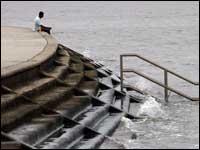Transcript
BROOKE GLADSTONE:
From WNYC in New York, this is NPR's On the Media. Bob Garfield is away this week. I'm Brooke Gladstone.
Six months after Katrina devastated the city of New Orleans, we went down there to survey the media landscape. We found that the aging infrastructure had been washed away, leaving little but opportunity. The TV stations were coping with a newfound hunger for news, the Internet was becoming a crucial source for citizen-generated information, and there was a new and growing Spanish-speaking population rebuilding the city, in need of a voice on the airwaves. New Orleans seemed to be a kind of media Petrie dish, a clean slate on which a new definition of urban media could be written.
Now, on the eve of the second anniversary of the disaster, we decided to check in to see how the experiment was going. In April of 2006, Greg Meffert was New Orleans' chief technology officer trying to wire the city with free wi-fi.
GREG MEFFERT:
You know, we have a scenario now where we can sit there and say we're like a laboratory for everything new. I don't want leading edge. I want bleeding edge.
BROOKE GLADSTONE:
Meffert has since left, but EarthLink has stepped in with a two-tiered wi-fi arrangement which offers service to everyone, but faster service for a price. Another innovation following the disaster was Spanish-language TV. During the storm, Ernesto Schweikert was begging for supplies - gasoline to keep the generators going for the city's only Spanish-language radio station.
ERNESTO SCHWEIKERT:
I was traveling to the different city halls, asking for help. Avoiding us completely. I mean, I felt so little.
BROOKE GLADSTONE:
But Schweikert told us in the spring of 2006 that he had dreams of building his own TV station. He got it - full power, digital-ready, now running a feed from Telemundo.
Meanwhile, the network affiliates, operating without Nielson ratings for nearly two years, pressed on. That gave them the freedom to serve audiences in new ways without getting a ratings report card.
Mason Granger, president and general manager of WDSU, NBC's affiliate in New Orleans, laid out that station's new commitment to news in the wake of the flood.
MASON GRANGER:
We didn't have an hour of news at noon before the hurricane and we now have two hours of morning news on Saturdays and three hours of morning news on Sundays. We also do a local program from 10:30 to 11 every night, Monday through Friday, which is geared specifically to Hurricane Katrina-related information and issues.
BROOKE GLADSTONE:
Most of those programs have continued. David Walker is the TV critic for The Times-Picayune. Eighteen months ago he told us that the media in New Orleans were like a jump-ball. We asked him if they're still in the air, even after the Nielsens returned this month.
DAVID WALKER:
Overall ratings for television news here are down compared with the July before the storm.
BROOKE GLADSTONE:
And yet there's no plans to discontinue some of that extended coverage.
DAVID WALKER:
No, for now, I think everybody's sort of waiting to see whether the Nielsen sample improves. I think there are some reservations by the broadcasters about the quality of the sample. I'm sure that everybody's poring over those numbers and trying to figure out what they mean.
BROOKE GLADSTONE:
Let's assume that those initial findings are borne out and that the audience for local TV news is actually shrinking. Is it possible that people are moving to online news sources?
DAVID WALKER:
I think that's one possibility. I also think - and this is just anecdotal, and actually, to be honest, it's sort of personal - I think there might be some news fatigue here that is compounded by just the daily frustration of existence here. And as important as it is for people to have information, there's not been an awful lot of good news coming on all those broadcasts.
The news menu is driven by a lot of crime stories and a lot of stories about the levees not being repaired and stories about poisonous FEMA trailers. And I just think it's human nature at some point for people to grow some scar tissue. I should note that the restart of the professional football season may change that a lot. [BROOKE LAUGHS]
Another thing that will probably drive viewers back to those broadcasts is we're moving toward the peak of hurricane season.
BROOKE GLADSTONE:
As a TV critic, what's it been like to see the big-time anchors telling your story?
GREG MEFFERT:
It's exhausting. The fear here splits two exactly opposite directions. One of the fears is, is that we'll be completely forgotten and that Anderson Cooper and Brian Williams will stop coming. And the fact is, is they haven't. Cooper's been here 20 times, Williams has been here 15 times to do live broadcasts from here.
The other fear is that we'll be too well remembered, and by that I mean every time Anderson Cooper does a setup in front of a flood-ruined house, it's potentially putting the message out there that all of the city is still in ruins. That's actually not the fact at all. The French Quarter and the Garden District and the sectors of town that tourists would visit, were they to come, are up and running.
BROOKE GLADSTONE:
Are they not coming?
GREG MEFFERT:
What's not coming back are the weekend visitors, the people who would drive from Birmingham or Dallas to spend a few days eating and drinking and having fun. And that may be because of the mixed message that they're getting from the national media.
There was a symposium of local hospitality industry leaders here early in the summer, and one of the panelists actually said he would smack Anderson Cooper if he could.
BROOKE GLADSTONE:
David Walker is The Times-Picayune TV critic.

